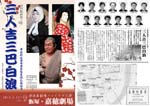 Today, I saw the kabuki play “Sannin Kichisa Tomoe no Shiranami(三人吉三巴白浪)” at Kaho Gekijō(嘉穂劇場), which is one of traditonal Japanese theaters in existence.
Today, I saw the kabuki play “Sannin Kichisa Tomoe no Shiranami(三人吉三巴白浪)” at Kaho Gekijō(嘉穂劇場), which is one of traditonal Japanese theaters in existence.
Nowadays, the theaters in Japan have chairs. But the old theaters in Japan had no chairs, and the audience sat on the floor with cushions(座布団). And they had Hanamichi(花道) and Suppon(スッポン), etc. Kaho Gekijō(嘉穂劇場) still has such styles.
The play started at 13:30 and ended at around 16:30. It took almost 3 hours and was a full-length play(通し狂言). But, I did not feel too long. I’ve ever heard the original scripts was very longer than the play in today.
The story is very complicated. If you have curiosity, please read this. (´∀`)
3 replies on “Sannin Kichisa Tomoe no Shiranami(三人吉三巴白浪)”
Hi there!
3 hours sounds very long! I don’t know anything about kabuki theater, and neither that much about occidental theater anyway, but still sounds like a lot. Did it a least have an intermission?
Interesting about the way the “stage” is constructed around japanese traditional theater it must be an interesting experience to have the actors all around you.
I hope you’re well.
Hi,
> 3 hours sounds very long!
Yes, it was long. But a good play makes my short sensible time (^^), so I did not feel so long.
> Did it a least have an intermission?
Yeah, of course. It had a full-time intermission, which was 15 minutes, and short curtain closing periods for quick scene changes, at which the audience can get up and walk away.
I think, Hanamichi, Suppon and Mawaributai (廻り舞台) are very important features for Japanese traditional stagings — not only for Kabuki but also for others. Apart from anything else, Hanamichi is good for fans who probably want to see an actor as nearly as possible (^o^).
Hi again, Delonix.
Further to my last comment.
> Hanamichi, Suppon and Mawaributai (廻り舞台) are very important features for Japanese traditional stagings
I wrote. But, the stage for Noh(能) and Kyōgen(狂言), which are also famous as Japanese traditional plays, has no such features and doesn’t need them. It is more simple. The features I wrote above are younger than Noh(能) and Kyōgen(狂言), and they evolved with Kabuki which is newer performing style than Noh(能) and Kyōgen(狂言).